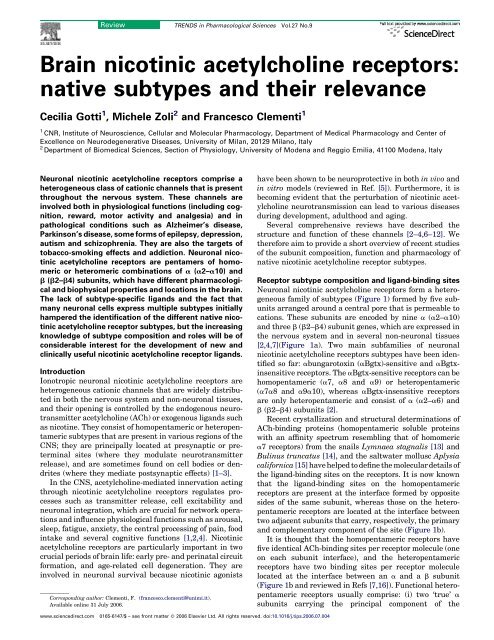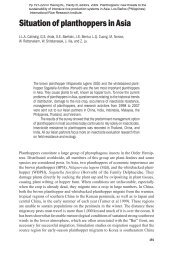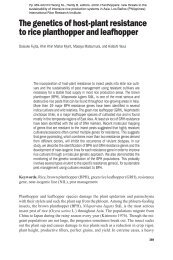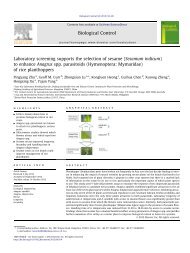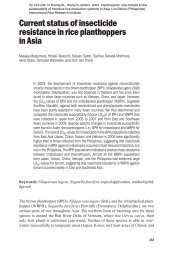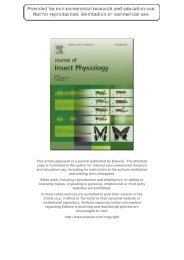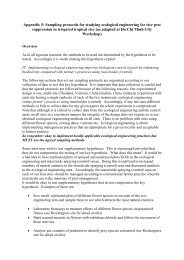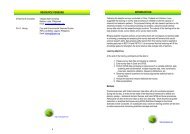Brain nicotinic acetylcholine receptors: native ... - Ricehoppers
Brain nicotinic acetylcholine receptors: native ... - Ricehoppers
Brain nicotinic acetylcholine receptors: native ... - Ricehoppers
Create successful ePaper yourself
Turn your PDF publications into a flip-book with our unique Google optimized e-Paper software.
Review TRENDS in Pharmacological Sciences Vol.27 No.9<br />
<strong>Brain</strong> <strong>nicotinic</strong> <strong>acetylcholine</strong> <strong>receptors</strong>:<br />
<strong>native</strong> subtypes and their relevance<br />
Cecilia Gotti 1 , Michele Zoli 2 and Francesco Clementi 1<br />
1 CNR, Institute of Neuroscience, Cellular and Molecular Pharmacology, Department of Medical Pharmacology and Center of<br />
Excellence on Neurodegenerative Diseases, University of Milan, 20129 Milano, Italy<br />
2 Department of Biomedical Sciences, Section of Physiology, University of Modena and Reggio Emilia, 41100 Modena, Italy<br />
Neuronal <strong>nicotinic</strong> <strong>acetylcholine</strong> <strong>receptors</strong> comprise a<br />
heterogeneous class of cationic channels that is present<br />
throughout the nervous system. These channels are<br />
involved both in physiological functions (including cognition,<br />
reward, motor activity and analgesia) and in<br />
pathological conditions such as Alzheimer’s disease,<br />
Parkinson’s disease, some forms of epilepsy, depression,<br />
autism and schizophrenia. They are also the targets of<br />
tobacco-smoking effects and addiction. Neuronal <strong>nicotinic</strong><br />
<strong>acetylcholine</strong> <strong>receptors</strong> are pentamers of homomeric<br />
or heteromeric combinations of a (a2–a10) and<br />
b (b2–b4) subunits, which have different pharmacological<br />
and biophysical properties and locations in the brain.<br />
The lack of subtype-specific ligands and the fact that<br />
many neuronal cells express multiple subtypes initially<br />
hampered the identification of the different <strong>native</strong> <strong>nicotinic</strong><br />
<strong>acetylcholine</strong> receptor subtypes, but the increasing<br />
knowledge of subtype composition and roles will be of<br />
considerable interest for the development of new and<br />
clinically useful <strong>nicotinic</strong> <strong>acetylcholine</strong> receptor ligands.<br />
Introduction<br />
Ionotropic neuronal <strong>nicotinic</strong> <strong>acetylcholine</strong> <strong>receptors</strong> are<br />
heterogeneous cationic channels that are widely distributed<br />
in both the nervous system and non-neuronal tissues,<br />
and their opening is controlled by the endogenous neurotransmitter<br />
<strong>acetylcholine</strong> (ACh) or exogenous ligands such<br />
as nicotine. They consist of homopentameric or heteropentameric<br />
subtypes that are present in various regions of the<br />
CNS; they are principally located at presynaptic or preterminal<br />
sites (where they modulate neurotransmitter<br />
release), and are sometimes found on cell bodies or dendrites<br />
(where they mediate postsynaptic effects) [1–3].<br />
In the CNS, <strong>acetylcholine</strong>-mediated innervation acting<br />
through <strong>nicotinic</strong> <strong>acetylcholine</strong> <strong>receptors</strong> regulates processes<br />
such as transmitter release, cell excitability and<br />
neuronal integration, which are crucial for network operations<br />
and influence physiological functions such as arousal,<br />
sleep, fatigue, anxiety, the central processing of pain, food<br />
intake and several cognitive functions [1,2,4]. Nicotinic<br />
<strong>acetylcholine</strong> <strong>receptors</strong> are particularly important in two<br />
crucial periods of brain life: early pre- and perinatal circuit<br />
formation, and age-related cell degeneration. They are<br />
involved in neuronal survival because <strong>nicotinic</strong> agonists<br />
Corresponding author: Clementi, F. (francesco.clementi@unimi.it).<br />
Available online 31 July 2006.<br />
have been shown to be neuroprotective in both in vivo and<br />
in vitro models (reviewed in Ref. [5]). Furthermore, it is<br />
becoming evident that the perturbation of <strong>nicotinic</strong> <strong>acetylcholine</strong><br />
neurotransmission can lead to various diseases<br />
during development, adulthood and aging.<br />
Several comprehensive reviews have described the<br />
structure and function of these channels [2–4,6–12]. We<br />
therefore aim to provide a short overview of recent studies<br />
of the subunit composition, function and pharmacology of<br />
<strong>native</strong> <strong>nicotinic</strong> <strong>acetylcholine</strong> receptor subtypes.<br />
Receptor subtype composition and ligand-binding sites<br />
Neuronal <strong>nicotinic</strong> <strong>acetylcholine</strong> <strong>receptors</strong> form a heterogeneous<br />
family of subtypes (Figure 1) formed by five subunits<br />
arranged around a central pore that is permeable to<br />
cations. These subunits are encoded by nine a (a2–a10)<br />
and three b (b2–b4) subunit genes, which are expressed in<br />
the nervous system and in several non-neuronal tissues<br />
[2,4,7](Figure 1a). Two main subfamilies of neuronal<br />
<strong>nicotinic</strong> <strong>acetylcholine</strong> <strong>receptors</strong> subtypes have been identified<br />
so far: abungarotoxin (aBgtx)-sensitive and aBgtxinsensitive<br />
<strong>receptors</strong>. The aBgtx-sensitive <strong>receptors</strong> can be<br />
homopentameric (a7, a8 and a9) or heteropentameric<br />
(a7a8 and a9a10), whereas aBgtx-insensitive <strong>receptors</strong><br />
are only heteropentameric and consist of a (a2–a6) and<br />
b (b2–b4) subunits [2].<br />
Recent crystallization and structural determinations of<br />
ACh-binding proteins (homopentameric soluble proteins<br />
with an affinity spectrum resembling that of homomeric<br />
a7 <strong>receptors</strong>) from the snails Lymnaea stagnalis [13] and<br />
Bulinus truncatus [14], and the saltwater mollusc Aplysia<br />
californica [15] have helped to define the molecular details of<br />
the ligand-binding sites on the <strong>receptors</strong>. It is now known<br />
that the ligand-binding sites on the homopentameric<br />
<strong>receptors</strong> are present at the interface formed by opposite<br />
sides of the same subunit, whereas those on the heteropentameric<br />
<strong>receptors</strong> are located at the interface between<br />
two adjacent subunits that carry, respectively, the primary<br />
and complementary component of the site (Figure 1b).<br />
It is thought that the homopentameric <strong>receptors</strong> have<br />
five identical ACh-binding sites per receptor molecule (one<br />
on each subunit interface), and the heteropentameric<br />
<strong>receptors</strong> have two binding sites per receptor molecule<br />
located at the interface between an a and a b subunit<br />
(Figure 1b and reviewed in Refs [7,16]). Functional heteropentameric<br />
<strong>receptors</strong> usually comprise: (i) two ‘true’ a<br />
subunits carrying the principal component of the<br />
www.sciencedirect.com<br />
0165-6147/$ – see front matter ß 2006 Elsevier Ltd. All rights reserved. doi:10.1016/j.tips.2006.07.004
Review TRENDS in Pharmacological Sciences Vol.27 No.9 483<br />
Figure 1. Regional distribution and subunit organization of the <strong>nicotinic</strong> <strong>acetylcholine</strong> <strong>receptors</strong>. (a) Regional distribution of the main <strong>nicotinic</strong> receptor subtypes in the<br />
rodent CNS. The subtypes present in the cortex, cerebellum, hippocampus, interpeduncular nucleus, medial habenula and pineal gland have been identified by binding,<br />
immunoprecipitation and/or immunopurification assays in tissue from rat and/or wild-type and/or receptor subunit knockout mice. The subtypes present in the amygdala,<br />
hypothalamus, locus coeruleus, olfactory bulb, raphe nuclei, spinal cord, substantia nigra–ventral tegmental area and thalamus have been deduced from in situ hybridization,<br />
single-cell PCR and binding studies of tissues obtained from rat and/or wild-type and/or knockout mice (reviewed in Refs [1,24,31,35]). (b) Organization and structure<br />
of heteropentameric and homopentameric subtypes. The pentameric arrangement of <strong>nicotinic</strong> <strong>acetylcholine</strong> receptor subunits in the heteropentameric a4b2, a4a6b2b3,<br />
a6b2b3 and homopentameric a7 subtypes and localization of the subunit interfaces of the ACh-binding site are shown. The homomeric a7 subtype has five identical AChbinding<br />
sites per receptor molecule (one on each subunit interface). The heteropentameric a4b2 <strong>receptors</strong> have two identical binding sites per receptor molecule, located at<br />
the interface between an a4 and a b2 subunit. The heteropentameric a6a4b2b3 subtype has two different binding sites per receptor molecule, located at the interface<br />
between an a4 and a b2 subunit, and at the interface between an a6 and a b2 subunit. The heteropentameric a6b2b3 subtypes has two identical binding sites per receptor<br />
molecule, located at the interface between an a6 and a b2 subunit [1,24,31,35]. In homopentameric <strong>receptors</strong>, the interface comprises opposite sides of the same subunit; in<br />
heteropentameric <strong>receptors</strong>, the interface is located between two adjacent subunits – one carrying the primary (P) component and the other carrying the complementary (C)<br />
component of the site. Part (a) reproduced, with permission, from Ref. [88].<br />
ACh-binding site (a2, a3, a4ora6); (ii) two non-a subunits<br />
carrying the complementary component of the AChbinding<br />
site (b2 orb4); and (iii) a fifth subunit (equivalent<br />
to b1 in muscle-type <strong>nicotinic</strong> <strong>acetylcholine</strong> <strong>receptors</strong>) that<br />
does not participate in ACh binding (a5, b3, but also b2<br />
or b4).<br />
www.sciencedirect.com
484 Review TRENDS in Pharmacological Sciences Vol.27 No.9<br />
Although it has been shown that a4b2 subtypes with<br />
different stoichiometry (a4) 2 (b2) 3 and (a4) 3 (b2) 2 can be<br />
generated in heterologous systems when the ratio of a4 to<br />
b2 subunits is changed or under different experimental<br />
conditions, no evidence of this stoichiometry has been<br />
found in brain.<br />
Critique of methods for identifying receptor subtype<br />
expression<br />
The identification of <strong>nicotinic</strong> <strong>acetylcholine</strong> receptor<br />
subtype composition is currently based on a combination<br />
of technical approaches and the availability of <strong>nicotinic</strong><br />
<strong>acetylcholine</strong> receptor subunit knockout or knock-in mice.<br />
Any revision of the three generally accepted compositional<br />
rules listed above (e.g. a different receptor stoichiometry<br />
with three ‘true’ a subunits and two non-a subunits, see<br />
above) would require our current deductions concerning<br />
receptor composition to be changed (see Refs [17,18]).<br />
The techniques currently used to identify <strong>nicotinic</strong> <strong>acetylcholine</strong><br />
receptor subtypes include the regional or cellular<br />
localization of subunit mRNA (by in situ hybridization or<br />
single-cell PCR) or proteins (by immunoprecipitation or<br />
immunocytochemistry), receptor subtype imaging (by<br />
autoradiography, positron emission tomography or functional<br />
magnetic resonance imaging), the assessment of<br />
subtype composition and pharmacology (by binding in<br />
tissue homogenates or immunopurification), and functional<br />
assays (based on neurotransmitter release or electrophysiological<br />
techniques).<br />
Interpreting the data obtained using these techniques<br />
requires some general caveats: namely, there is not always<br />
a correlation between mRNA levels and concentrations of<br />
the expressed subunits (see Ref. [19]); the total amount of<br />
subunit proteins can be misleading because protein subunits<br />
must assemble properly to make functional <strong>receptors</strong>;<br />
and pharmacologically identified binding sites are not<br />
always functional or located in the physiologically relevant<br />
membrane domain. More specifically, some essential technical<br />
issues should be taken into consideration.<br />
In situ hybridization using hydrolyzed riboprobes is<br />
more sensitive than in situ hybridization using oligoprobes,<br />
but is prone to show false positives in view of the<br />
difficulty in testing probe specificity (e.g. see Ref. [20]).<br />
Single-cell PCR is highly sensitive and specific but only<br />
gives all-or-none results and might therefore overestimate<br />
the relevance of some subunits: for example,<br />
compare the a2, a3 and a6 data obtained using<br />
oligoprobes, riboprobes and single-cell PCR in midbrain<br />
dopamine neurons, with those obtained in a3 and a6<br />
knockout mice and immunoprecipitation studies [5,20–<br />
24].<br />
It has been recently shown that most of the available<br />
anti-subunit antibodies used in immunocytochemistry<br />
are not specific because they give similar staining<br />
patterns in tissues obtained from the respective wildtype<br />
and subunit knockout mice [25]. The specificity of<br />
the antibodies must therefore be tested first in wild-type<br />
and knockout mice.<br />
The anti-subunit antibodies used in immunoprecipitation<br />
and immunopurification experiments do not have<br />
the specificity limitations of those used in immunocytochemistry,<br />
possibly because of the antigen selection<br />
made by receptor binding. To quantify the <strong>receptors</strong> in<br />
<strong>native</strong> tissue, however, it is essential to determine the<br />
binding capacity of the antibodies (which is usually<br />
70–90% of the subunit targeted by the antibodies). The<br />
spatial resolution of the immunoprecipitation technique<br />
at a regional level is of course limited.<br />
The main limitation of functional and binding assays is<br />
the lack of subtype-specific ligands, but the use of these<br />
assays has greatly improved with the availability of<br />
subunit-specific knockout and knock-in mice.<br />
The techniques described above have been applied to<br />
both wild-type and, more recently, genetically engineered<br />
mice.<br />
In terms of constitutive knockout mice, the possible<br />
existence of developmental compensations for the loss<br />
of a targeted gene must always be considered and, in<br />
principle, cannot be excluded. No evidence of such<br />
compensation has been found in b2-deficient mice because<br />
the targeted re-expression of the b2 subunit in the<br />
mesolimbic pathway of adult b2-deficient mice completely<br />
restores all of the wild-type phenotypes related to this<br />
pathway [26]. In addition, no compensation has been<br />
observed in expression of the other <strong>nicotinic</strong> <strong>acetylcholine</strong><br />
receptor subunits or in that of nonb2* <strong>nicotinic</strong> <strong>acetylcholine</strong><br />
receptor subtypes [27], or in the function of the spared<br />
<strong>nicotinic</strong> <strong>acetylcholine</strong> receptor subtypes [22,24] (note that<br />
an asterisk indicates that other, unidentified subunits<br />
might also be present in the receptor subtype). By contrast,<br />
in a6 knockout mice overexpression of the a4 subunit<br />
compensates for the loss of a6* <strong>nicotinic</strong> <strong>acetylcholine</strong><br />
<strong>receptors</strong> in striatal regions [24], and complex functional<br />
compensation might occur that must be considered when<br />
interpreting functional studies of specific subtypes.<br />
Native subtypes<br />
In defining the <strong>native</strong> subtypes of <strong>nicotinic</strong> <strong>acetylcholine</strong><br />
receptor, we will follow the rules and caveats described<br />
above. Table 1 and Figure 1 show the composition,<br />
localization and number of <strong>native</strong> subtypes identified in<br />
different brain regions of the animal species studied so far.<br />
The subtypes are identified by the list of their subunits.<br />
Localization and subunit composition<br />
In agreement with in situ hybridization studies showing<br />
the widespread distribution of a4, b2 and a7 subunit<br />
mRNAs in the brain, a7 <strong>receptors</strong> and <strong>nicotinic</strong> <strong>acetylcholine</strong><br />
<strong>receptors</strong> containing the a4 and b2 subunits are the<br />
most expressed subtypes, although their regional expression<br />
varies in different vertebrate species (Figure 1 and<br />
Table 1). In primate brain, the widespread distribution of<br />
the a2 subunit is comparable to that of the a4 subunit [28].<br />
The other subunits of the aBgtx-insensitive subclass have<br />
a much more restricted distribution, although they might<br />
be highly expressed and have important functions in these<br />
regions (see later) [20].<br />
The specificity of aBgtx for <strong>receptors</strong> containing the<br />
a7–a10 subunits has enabled the precise cellular and<br />
subcellular localization of aBgtx-sensitive <strong>nicotinic</strong> <strong>acetylcholine</strong><br />
<strong>receptors</strong> to be determined by binding studies.<br />
These <strong>receptors</strong> are highly expressed in the cortex,<br />
www.sciencedirect.com
Review TRENDS in Pharmacological Sciences Vol.27 No.9 485<br />
Table 1. Identification and quantification of <strong>nicotinic</strong> <strong>acetylcholine</strong> receptor subtypes expressed in the CNS<br />
Human Monkey Rat Mouse Chick<br />
Cortex<br />
aBgtx-R a 10.6 2 [45] 22.4 4 [51] 48.4 4 [35] 38.0 3 [24] n.d.<br />
Epi-R b 12.5 1 [45] 41.6 4 [51] 98.4 8 [35] 79.1 6 [24] 107 6 [52]<br />
Subtype (% of Epi-R) c a2b2* (10) [45] a2b2* (4) [51] a4a5b2 (15) [35] a4b2 (65) [24] a2a4b2* (5) [52]<br />
a4b2* (65) [45] a3b2* (13) [51] a4b2 (70)[35] a4a5b2 (15) [24] a4b2 (75) [52,53]<br />
a4b2 (35) [51] a4a5b2 (10)[53]<br />
a2a4b2* (10) [51]<br />
Cerebellum<br />
aBgtx-R n.d. n.d.<br />
Epi-R 45 2 [32] 56 8 [2]<br />
Subtype (% of Epi-R) a3b4 (22)[32]<br />
a3a4b2 (10) [32]<br />
a3a4b4 (12) [32]<br />
a3b2b4 (12) [32]<br />
a3a4b4 (12) [32]<br />
Hippocampus<br />
aBgtx-R 83.6 2 [2] 87.3 13 [2]<br />
Epi-R 44.5 8 [2] 85.6 11 [2]<br />
Subtype (% of Epi-R) a4b2 (75)[2] a4b2 (75) [2]<br />
a4a5b2 (15) [2] a4a5b2 (15) [2]<br />
Lateral geniculate nucleus<br />
aBgtx-R 65 5 [37]<br />
Epi-R 264 10 [37]<br />
Subtype (% of Epi-R) a2a6b2* (4) [37]<br />
a3b2* (3) [37]<br />
a4a6b2b3 (9)[37]<br />
a4b2 (57)[37]<br />
a4a5b2 (7) [37]<br />
a6b2b3 (10) [37]<br />
Midbrain<br />
aBgtx-R 50 10 [31]<br />
Epi-R 144 6 [31]<br />
Subtype (% of Epi-R) a4b2* [31]<br />
a3b3* [31]<br />
a3b3* [31]<br />
a4b2* [31]<br />
a6b3* [31]<br />
Pineal gland<br />
aBgtx-R<br />
n.d.<br />
Epi-R 300 [54]<br />
Subtype (% of Epi-R) a3b4 (90)[54]<br />
Superior colliculus<br />
aBgtx-R 73 3 [37] n.d. 1833 260 [52]<br />
Epi-R 169 3 [37] 201 11 [37] 225 10 [52]<br />
Subtype (% of Epi-R) a3b2* (10) [37] a3b2* (11) [37] a2a4b2 (30)[52]<br />
a4b2 (44)[37] a4b2* (48) [37] a2a4b2 (5)[52]<br />
a4a5b2 (6) [37] a6b2b3* (31) [37] a4b2 (55) [52]<br />
a6b2b3 (18) [37]<br />
a4a6b2b3 (12)[37]<br />
Striatum<br />
aBgtx-R n.d. 12.1 2 [51] 47 2 [35] 50 1 [24]<br />
Epi-R 55.0 7 [45] 55.5 4 [51] 154 15 [35] 72 1 [24]<br />
Subtype (% of Epi-R) a4b2* (76) [45] a3b2* (14) [51] a4b2 (42)[35] a4b2 (46) [24]<br />
a6b2* (17) [45] a4b2* (45) [51] a4a5b2 (19) [35] a4a5b2 (12) [24]<br />
a6b2* (10) [51] a6a4b2b3 (8)[35] a6a4b2b3 (11) [24]<br />
a6a4b2* (10) [51] a6b2b3 (12) [35] a6b2b3 (19) [24]<br />
Retina<br />
aBgtx-R 44.2 4 [19] 1330 100 [29]<br />
Epi-R 202 17 [19] 247 21 [55,56]<br />
Subtype (% of Epi-R) a2 and/or a3b2* (11) [19] a4b4 (25) [55]<br />
a2 and/or a3b4* (3) [19] a6b3b4* (30) [57]<br />
a4b2* (47) [19] b2* (32) [56]<br />
a4b2b3* (15) [19] b4* (78) [56]<br />
a6a4b2b3 (11)[19]<br />
a aBgtx-Rs are abungarotoxin <strong>receptors</strong> measured by 125 I-labeled abungarotoxin binding and are expressed as fmol per mg of protein.<br />
b Epi-Rs are epibatidine <strong>receptors</strong> measured by [ 3 H]epibatidine binding and are expressed as fmol per mg of protein.<br />
c % of Epi-R represents the percentage of the subtype over the total amount of epibatidine <strong>receptors</strong> in the tissue. Abbreviation: n.d., not determined.<br />
www.sciencedirect.com
486 Review TRENDS in Pharmacological Sciences Vol.27 No.9<br />
hippocampus and subcortical limbic regions, and are<br />
expressed at low levels in the thalamic regions and basal<br />
ganglia. Affinity purification of these <strong>receptors</strong> from the<br />
brains of different species has confirmed that a7 <strong>receptors</strong><br />
are pentamers of a single a7 subunit in rat and chick brain,<br />
and that chick brain also contains two additional aBgtxsensitive<br />
subtypes: the homopentameric a8 and the heteropentameric<br />
a7a8 <strong>receptors</strong> [29].<br />
An a7 gene that incorporates a unique 87-base-pair<br />
cassette exon has recently been identified. When expressed<br />
in oocytes, it forms channels with a slower kinetics and<br />
reversible aBgtx binding [30]. Immunolocalization studies<br />
suggest that this subtype constitutes a distinct subset of a7<br />
<strong>receptors</strong>.<br />
aBgtx-sensitive <strong>receptors</strong> containing the a9 and/or a10<br />
subunits have not been found in brain, and their coexpression<br />
is limited to the cochlea and a few ganglia. The a9<br />
subunit forms homomeric channels, whereas the a10 subunit<br />
forms functional channels only when it is coexpressed<br />
with the a9 subunit [2].<br />
Recent studies have shown that the a7 subunit can also<br />
form functional channels with the subunits of the aBgtxinsensitive<br />
subfamily in heterologous systems, but so far<br />
there is no biochemical evidence of their existence in vivo<br />
(reviewed in Ref. [2]).<br />
The a4b2 subtype was the first to be biochemically and<br />
pharmacologically characterized in total rat brain<br />
(reviewed in Ref. [29]) and has been subsequently shown<br />
to constitute the principal <strong>nicotinic</strong> <strong>acetylcholine</strong> receptor<br />
subtype in subregions such as the cortex, striatum, superior<br />
colliculus, lateral geniculate nucleus and cerebellum<br />
[5,31,32] (Table 1). Accordingly, b2ora4 subunit knockout<br />
mice lose most of their high-affinity <strong>receptors</strong> for <strong>nicotinic</strong><br />
agonists in the CNS [27,33].<br />
In agreement with the data on mRNA distribution,<br />
receptor subtypes containing the a3, a6, b3 orb4 subunits<br />
have a relatively restricted distribution in the brain. In the<br />
neuronal populations in which they are expressed (e.g.<br />
a6b3* <strong>receptors</strong> in midbrain dopamine neurons, or<br />
a3b4* <strong>receptors</strong> in medial habenula neurons), however,<br />
they can constitute the main subpopulations of <strong>nicotinic</strong><br />
<strong>acetylcholine</strong> <strong>receptors</strong> with a significant function.<br />
The a2b2, a2b4, a3b2, a3b4, a6b2 and a6b4 <strong>nicotinic</strong><br />
<strong>acetylcholine</strong> receptor subunits can either constitute simple<br />
subtypes or form one of the two ACh-binding interface<br />
in complex subtypes – for example, a4a6b2* in the striatum<br />
and visual pathways (Figure 1b), a3a4b2ora3a4b4in<br />
cerebellum [32], and a2a4b2* in retina [19,34]. Usually,<br />
when multiple a or b subunits are coexpressed, only some<br />
of the many possible subunit combinations are actually<br />
assembled: for example, in the rat midbrain almost all<br />
dopamine neurons express a4, a5, a6, b2, and b3 [22], but<br />
a6b3 and a4a5 subunits are preferentially coassembled in<br />
dopamine striatal terminals [24,35].<br />
The factors that contribute to preferential subunit<br />
assembly are poorly understood and might include the<br />
influence of the chaperone molecules, relative subunit<br />
concentration and intrinsic affinities between pairs of<br />
subunits. These possibilities are also suggested by recent<br />
findings in b3 knockout mice that show a decrease in the<br />
expression of a6* <strong>receptors</strong>, but no change in the level of<br />
a6 mRNA[36], in dopamine cell bodies in the midbrain<br />
and, more markedly, in their terminal field in the striatum<br />
[31]. This decrease indicates that the b3 subunit is<br />
important for the formation of most a6b2* or a6a4b2*<br />
pentamers, and its loss causes defects in <strong>nicotinic</strong><br />
<strong>acetylcholine</strong> receptor assembly, degradation and/or<br />
trafficking.<br />
Several studies have clearly shown that the same<br />
neuronal population can express multiple subtypes of<br />
<strong>nicotinic</strong> <strong>acetylcholine</strong> receptor. The reasons for this<br />
heterogeneity are understood only partially [7]. Specific<br />
electrophysiological features of the subtypes (e.g. high<br />
versus low Ca 2+ permeability or fast versus slow desensitization<br />
rates) might make their coexpression functionally<br />
relevant; alter<strong>native</strong>ly, the various subtypes might<br />
be needed for preferential targeting to different cell<br />
compartments. In vivo evidence for preferential targeting<br />
of <strong>native</strong> <strong>nicotinic</strong> <strong>acetylcholine</strong> receptor subtypes is still<br />
circumstantial, but some subtypes, for example, a6b3*<br />
<strong>receptors</strong> in midbrain dopamine neurons or retinal<br />
ganglionic cells, might be targeted to the nerve terminal<br />
compartment in preference to other subtypes, such as a4*<br />
[31,35,37]. However, the precise determinants of these<br />
targeting processes are not well understood.<br />
Pharmacology<br />
The evidence that <strong>native</strong> aBgtx-insensitive <strong>nicotinic</strong><br />
<strong>acetylcholine</strong> <strong>receptors</strong> are extremely heterogeneous has<br />
increased the complexity of studying their pharmacological<br />
profiles. Because a ligand-binding site is formed by the<br />
interface between a true a and a b subunit, in Table 2 we<br />
have summarized the pharmacological characteristics of<br />
a–b interfaces in heterologously expressed and <strong>native</strong><br />
subtypes.<br />
The agonist profile is similar for the different interfaces.<br />
The agonists epibatidine, cytisine, ACh, 1,1-dimethyl-4-<br />
phenylpiperazinium (DMPP), nicotine and the newly<br />
synthesized nicotine derivative A-85380 have limited<br />
selectivity and cannot discriminate among the different<br />
subtypes in functional assays; however, their higher affinity<br />
(particularly that of A-85380) for the aX–b2 than the<br />
aX–b4 interface can be used to characterize the various<br />
subtypes, at least in binding studies [11].<br />
The recent discovery of Conus peptides in the venom of<br />
cone snails has made it possible to discriminate subtypes in<br />
both binding and functional tests. One typical example is<br />
aConotoxin MII (aCntxMII), which can block the response<br />
of ACh to heterologously expressed a6b2 and a3b2 subtypes<br />
with nanomolar affinity but is 100–10 000 times less<br />
potent towards the other subtypes [11,38,39]. The specificity<br />
of aCntxMII for <strong>native</strong> subtypes has been demonstrated<br />
by binding studies (Table 2), and its use has<br />
helped to define different interfaces in the same receptor.<br />
In the striatum, it has extremely low affinity for the a4b2<br />
subtype, both high and low affinity for a6* <strong>receptors</strong><br />
(a6b2b3 and a4a6b2b3 subtypes) purified from wild-type<br />
mice, and a single high affinity for the a6b2b3 subtype<br />
purified from a4 knockout mice [24]. The low-affinity binding<br />
site for aCntxMII on the wild-type a6* receptor is<br />
due to the presence of an a4–b2 interface (Figure 1b)<br />
that is absent in the striatal a6* <strong>receptors</strong> purified from<br />
www.sciencedirect.com
Review TRENDS in Pharmacological Sciences Vol.27 No.9 487<br />
Antagonist profile aCntxMII<br />
Table 2. Pharmacological characteristics of the a–b and a–a interfaces<br />
Binding studies a<br />
Functional studies a<br />
Interface b Agonist profile A-85380 ACh<br />
aCntx MII aCntx BuIA aCntx PIA<br />
K i<br />
K i K i<br />
IC 50<br />
IC 50<br />
IC 50<br />
a2–b2 E>A*>C>AN>D 0.07 11 DHE>MLA>Mec n.d. >1000 800 >10 000<br />
a3–b2 E>A*>D>C>N>A 0.21 56 DHE>MLA>Mec 50 0.5–2.2 5.72 74.2<br />
a4–b2 E>A*>C>N>A>D 0.14 44 DHE>MLA>Mec >1000 430 10 400 >10 000<br />
a6–b2 E>C>N>A>D 0.12 2024 MLA>DHE>Mec 1.1 0.39 0.26* 0.69*<br />
a2–b4 E>C>A*>N-A>D 18 110 DHE>MLA>Mec n.d. >100 121 >10000<br />
a3–b4 E>A*>C>N>D>A 78 850 DHE>MLA>Mec >1000 >100 27.7 518<br />
a4–b4 E>C>A*>N>A>D 8.1 99 MLA>DHE>Mec n.d. >10 000 69.9 >10 000<br />
a6–b4 E>C>N>D>A n.d. 59 MLA>DHE>Mec 4.3 n.d. 1.54 33.5<br />
Agonist profile Nic K i ACh K i Antagonist profile aBgtx K i ACh EC 50 Nic EC 50 TUB IC 50<br />
a7–a7 E>N>C>A 470 14300 MLA>TUB>DHE 1–2.4 112 000 7800 140<br />
a8–a8 E>N>C>A 10 c 60 c MLA>TUB>DHE 0.02 c 1900 1000 600<br />
4500 d 7000 d 3.6 d<br />
a7–a8 E>N>C>A 130 2600 n.d. 2.4 n.d. n.d. n.d.<br />
a The agonist and antagonist profiles and K i (nM) data come from binding studies [24,55,58–60], whereas IC 50 and EC 50 (nM) values were determined by electrophysiological<br />
experiments on transfected or <strong>native</strong> purified subtypes [24,37,38,40,41,61].<br />
b For the a2–b2, a3–b2, a4–b2, a2–b4, a3–b4, a4–b4 interfaces, the data were obtained from cells transfected in pairwise combinations [58]. The K i values of the a6–b2 interface<br />
come from experiments on <strong>native</strong> a6 <strong>receptors</strong> immunopurified from a4 knockout mice [24], whereas the aCntx BuIA and aCntx PIA IC 50 values were obtained from<br />
electrophysiological experiments on ra6–a3b2 chimera. The values of the a6–b4 interface refer to cells transfected with the chick a6b4 subunits [55],anra6–a3b4 chimera [41]<br />
or ra6–b4 [40]. For the a7–a7 [59], a8–a8 [60], a7–a8 [59] interfaces, the binding data were determined on immunopurified subtypes [59,60], whereas the functional data are<br />
from oocyte-expressed subtypes [61]. Abbreviations: A*, A-85380; A, <strong>acetylcholine</strong>; C, cytisine; aCntx, aconotoxin; D, DMPP; DHE, dihydro-b-erythroidine; E, epibatidine; EC 50 ,<br />
effector concentration for half maximal response; IC 50 , inhibitor concentration for half-maximal response; Mec, mecamylamine; MLA, methyllycaconitine; N, nicotine; n.d.,<br />
not determined; TUB, D-tubocurarine.<br />
c High-affinity site.<br />
d Low-affinity site.<br />
a4 knockout mice, which therefore have two high-affinity<br />
binding sites.<br />
aCntxMII has a higher affinity for the a6b2b3 receptor<br />
(inhibition constant, K i = 1 nM) than for the a3b2* subtypes<br />
(K i = 50 nM) [37], but this difference is not large<br />
enough to discriminate the subtypes functionally. The<br />
newly discovered aConotoxin PIA and modified aCntxMII<br />
[39] can, however, distinguish the a3b2* and a6b2* subtypes<br />
[40]. The newly discovered aConotoxin BuIA<br />
potently blocks a3* and a6* <strong>nicotinic</strong> <strong>acetylcholine</strong> receptor<br />
subtypes [41] (Table 2). This toxin binds <strong>receptors</strong><br />
containing either b2 orb4 subunits, but its kinetics of<br />
unblocking depend on the b subunit: b4* <strong>nicotinic</strong> <strong>acetylcholine</strong><br />
<strong>receptors</strong> have much slower off times than have<br />
the corresponding b2* <strong>receptors</strong>. These newly discovered<br />
aConotoxins have provided considerable insights into the<br />
subunit composition of brain <strong>nicotinic</strong> <strong>acetylcholine</strong> <strong>receptors</strong><br />
and might form templates for the design of new ligands<br />
for these <strong>receptors</strong>.<br />
In the chick CNS, some aBgtx-sensitive <strong>receptors</strong> have<br />
an a8–a8 interface [29]; this interface has a higher affinity<br />
for <strong>nicotinic</strong> agonists than the a7–a7 interface, whereas<br />
the a7–a8 interface has an intermediate affinity (Table 2).<br />
Functional studies<br />
Postsynaptic a7*, a4b2* and a3b4* receptor subtypes have<br />
been found in various regions of the CNS, and other postsynaptic<br />
heteropentameric subtypes might exist. There is,<br />
however, a general consensus that the <strong>nicotinic</strong> <strong>acetylcholine</strong><br />
<strong>receptors</strong> present at presynaptic or preterminal sites<br />
are physiologically more important [10,11]. Table 3 summarizes<br />
the different <strong>nicotinic</strong> <strong>acetylcholine</strong> receptor subtypes<br />
involved in neurotransmitter release in different<br />
areas of the brain.<br />
In ex vivo release experiments, the use of slices<br />
(which preserve some of their existing neuroanatomical<br />
connections) or synaptosomes (which are isolated nerve<br />
terminals) can give complementary results. For example,<br />
studies using aConotoxin AuIB have established<br />
that 30% of noradrenaline release from hippocampal<br />
synaptosomes is due to the a3b4* subtype [10], whereas<br />
release studies using hippocampal slices and electrophysiological<br />
recordings have shown that noradrenaline<br />
release is also indirectly modulated via an a7 receptor<br />
located in glutamate afferents and g-amino butyric acid<br />
(GABA)-containing interneurons, thereby demonstrating<br />
that there is cross-talk among neurotransmitters in<br />
modulating noradrenaline release [42].<br />
Studying the subtypes involved in neurotransmitter<br />
release can also give different results, depending on<br />
whether they are done in simple ex vivo systems or in<br />
more complex in vivo circuits. For example, a6* <strong>receptors</strong><br />
mediate aCntxMII-sensitive dopamine release from<br />
striatal synaptosomes, but do not seem to be involved in<br />
the dopamine release induced by systemic nicotine in vivo,<br />
as demonstrated by microdialysis studies of freely moving<br />
wild-type and a6 knockout mice [36].<br />
In contrast to glutamate release, which is directly<br />
controlled only by a7 <strong>receptors</strong>, the release of all<br />
other neurotransmitters seems to be regulated by<br />
multiple subtypes (Table 3). Moreover, owing to the<br />
complexity of neuronal networks, neurotransmitter<br />
release from a neuron is often controlled by the activation<br />
of <strong>nicotinic</strong> <strong>acetylcholine</strong> <strong>receptors</strong> located on other neurons<br />
(Table 3).<br />
In summary, the predominantly presynaptic localization<br />
and widespread distribution of <strong>nicotinic</strong> <strong>acetylcholine</strong><br />
<strong>receptors</strong> in several brain circuits makes it particularly<br />
difficult to characterize functionally the subtypes involved<br />
in specific behavioral or complex brain roles, although the<br />
use of genetically engineered mice should make this easier<br />
in the future.<br />
www.sciencedirect.com
488 Review TRENDS in Pharmacological Sciences Vol.27 No.9<br />
Table 3. Nicotinic <strong>acetylcholine</strong> <strong>receptors</strong> involved in neurotransmitter release in brain<br />
Glu ACh DA GABA NA<br />
Cerebellum a7 (r) [4]<br />
Cortex a7 (r) a [10] a4b2* (r) [11] a3b2* (h) [63]<br />
b2* (r) [11,62] axb4* (r) [11] a4b2* (r) a [64]<br />
a3 and/or a6b2* (r)<br />
Hippocampus a7 (r) a [42] a4b2* (r) a [10] a3b4* (r) [11,65] a7 (r) [10] a3b2* (r) [10]<br />
axb4* (r) a [10] a4b2* (r) [11] a4b2* (r) [11]<br />
a3b4* (r) a [42]<br />
a7 (r) [11]<br />
Interpeduncular nucleus b4* (m) a [10] axb2* (m) [10]<br />
Hypothalamus xb2* (r) [66]<br />
Midbrain a4b2* (m, r) [10] a4b2* (m, r) [10]<br />
Lateral geniculate nucleus a7 (c) [10]<br />
Olfactory tubercle a7 (r) [10] a4b2* (m) a [67],<br />
a3 and/or a6b2* (m)<br />
[67]<br />
Superior colliculus a7 (m)[68] a3b2* [68] and/or<br />
a6b2* (m) [68]<br />
Striatum a7 (r) [10] a4b2* (m) a [24,64,69]<br />
a4a5b2* (m) a [24,69]<br />
a6a4b2b3 (m) a [24,69]<br />
a6b2b3 (m) a [24,64,69]<br />
a7 (r) [10]<br />
Thalamus a4b2* (m) [67] a4b2* (m) [10]<br />
a Tested in synaptosomes. Abbreviations: ACh, <strong>acetylcholine</strong>; c, chick; DA, dopamine; GABA, g-aminobutyric acid; Glu, glutamate; h, human; m, mouse; NA, noradrenaline; r, rat.<br />
Involvement of <strong>native</strong> subtypes in pathological states<br />
Studies of receptor subunit knockout mice have shown that<br />
brain <strong>nicotinic</strong> <strong>acetylcholine</strong> <strong>receptors</strong> are not essential for<br />
survival or for the execution of basic behaviors [2]. They<br />
are, however, important for the fine control of several more<br />
sophisticated and complex behaviors that can be evaluated<br />
only by means of appropriate tests or in particularly labile<br />
situations such as the aged brain. These findings place<br />
<strong>nicotinic</strong> <strong>acetylcholine</strong> <strong>receptors</strong> in a different, and perhaps<br />
more important, perspective because of their involvement<br />
in brain diseases and the possibility of using them as drug<br />
targets. Many pathological situations involve a lack of fine<br />
Table 4. Involvement of <strong>nicotinic</strong> <strong>acetylcholine</strong> <strong>receptors</strong> in brain diseases<br />
Disease Epi binding aBgtx binding Effects of Effects of smoking Level of heteromeric subunit<br />
<strong>nicotinic</strong> drugs<br />
(Ago or Ant)<br />
Tourette’s syndrome Both P [2,70] P [2,71]<br />
Autism Parietal cortex # [72] Cortex ! [73] Parietal cortex b2 # [2,71]<br />
Cerebellum # [72] Cerebellum " [73] Cerebellum a4 # [2,71]<br />
Thalamus # [72] Thalamus b2 # [2,71]<br />
Schizophrenia ! [74] Hippocampus # P (Ago) [77] P [72] Hippocampus a4 ! [73,78]<br />
[75,76]<br />
Thalamus b2 ! [76]<br />
Thalamus # [76]<br />
Cortex a3 ! [76]<br />
Frontal cortex # [75]<br />
Cingulate cortex #<br />
[76]<br />
Depression P (Ago) [79,80] P [2]<br />
Attention deficit hyperactivity<br />
P (Ago) [77,78] P [2,77]<br />
disorder<br />
Parkinson’s disease Striatum # [81] Cerebellum # [2] P (Ago) [77] P [77] Striatum a6, b3 # [45]<br />
SN # [82] Cortex # [77,83] n.e. Cortex a4, b2 # [81]<br />
Cortex # [77,83]<br />
Alzheimer’s disease Cortex # [77] Temporal cortex !<br />
P [2] Cortex a4, b2 # [45,71]<br />
Hippocampus # [77] [78]<br />
Cortex a3 ! [85]<br />
Presubiculum # [2,84]<br />
Thalamus # [2,84]<br />
Striatum # [2,84]<br />
Thalamus # [85]<br />
Aging Frontal cortex # [2,86] Hippocampus !<br />
Cortex a4, b2 # [2,86]<br />
Hippocampus # [2,86] [2,86]<br />
Cortex a3 ! [2,86]<br />
Entorhinal cortex #<br />
[2,86]<br />
Thalamus # [2,86]<br />
Tobacco dependence Cortex " [2,87] P (Ago) [77] P [2] Hippocampus a4 " [71]<br />
Entorhinal cortex a4 " [66]<br />
Dentate gyrus a7 " [87]<br />
a Determined in synaptosomes. Abbreviations: ", increased; #, decreased; !, not different from control; Ago, agonists; Ant, antagonists; aBgtx, 125 I-labeled abungarotoxin;<br />
Epi, [ 3 H]epibatidine; n.e., no effect; P, positive; SN, substantia nigra.<br />
www.sciencedirect.com
Review TRENDS in Pharmacological Sciences Vol.27 No.9 489<br />
control and tuning, rather than the complete loss of a<br />
particular function, and the pharmacological restoration<br />
of appropriate tuning could have a crucial clinical effect.<br />
Nicotinic <strong>acetylcholine</strong> <strong>receptors</strong> are involved in the<br />
pathogenesis or symptomatology of several diseases of<br />
the CNS, which can be divided into two groups: those in<br />
which a <strong>nicotinic</strong> <strong>acetylcholine</strong> receptor subunit gene is<br />
mutated and a receptor subtype function is altered, such as<br />
autosomal dominant frontal lobe epilepsy; and those involving<br />
a modification in the number of <strong>nicotinic</strong> <strong>acetylcholine</strong><br />
<strong>receptors</strong>, such as schizophrenia, Tourette’s syndrome,<br />
attention deficit hyperactivity disorder, autism, depression<br />
and anxiety, and the neurodegenerative Alzheimer’s and<br />
Parkinson’s diseases [1,2,4]. Nicotinic <strong>acetylcholine</strong> <strong>receptors</strong><br />
are also the targets responsible for the behavioral<br />
effects of nicotine and tobacco dependence (Table 4).<br />
For most diseases, the involvement of <strong>nicotinic</strong><br />
<strong>acetylcholine</strong> <strong>receptors</strong> has been deduced on the basis of<br />
binding experiments with nonselective <strong>nicotinic</strong> ligands,<br />
clinical response to <strong>nicotinic</strong> drugs, smoking behavior, or<br />
similarities with experimental models in which <strong>nicotinic</strong><br />
<strong>acetylcholine</strong> <strong>receptors</strong> have been modified [43,44].<br />
Although these data are sufficient to suggest the involvement<br />
of <strong>nicotinic</strong> <strong>acetylcholine</strong> <strong>receptors</strong>, much less is<br />
known about the receptor subtypes involved and their<br />
precise role. Apart from Parkinson’s disease, in which a<br />
marked reduction in the number of a6b3* <strong>receptors</strong> in the<br />
dopamine pathway has been clearly documented, multiple<br />
receptor subtypes seem to be affected in most disorders<br />
[2,45].<br />
Because the main localization of <strong>nicotinic</strong> <strong>acetylcholine</strong><br />
<strong>receptors</strong> is on presynaptic structures that have a modulatory<br />
role on neurotransmission, a change in receptor<br />
number (as occurs in various diseases) does not lead to<br />
overt behavioral modifications and thus a pharmacological<br />
approach based on <strong>nicotinic</strong> agents will probably have<br />
relatively slight effects, as can be seen from the relative<br />
failure of <strong>nicotinic</strong> therapy in Alzheimer’s disease, Parkinson’s<br />
disease, Tourette’s syndrome, schizophrenia and<br />
depression. A <strong>nicotinic</strong> approach therefore seems more<br />
appropriate as an adjuvant therapy. It is difficult to interpret<br />
<strong>nicotinic</strong> therapies, however, because it is not clear<br />
whether the beneficial effects of <strong>nicotinic</strong> agonists, as seen<br />
in Tourette’s syndrome and in smoking cessation, are due<br />
to the activation or desensitization of <strong>nicotinic</strong> <strong>acetylcholine</strong><br />
<strong>receptors</strong> [4,46].<br />
Mutations in the channel region of the a4orb2 subunits<br />
have been found in some families suffering from autosomal<br />
dominant frontal lobe epilepsy. The expression of these<br />
mutations in heterologous systems has given rise to <strong>nicotinic</strong><br />
<strong>acetylcholine</strong> <strong>receptors</strong> with gain (a4) or loss (b2) of<br />
function but, in both cases, the <strong>nicotinic</strong> <strong>acetylcholine</strong><br />
<strong>receptors</strong> have higher ACh sensitivity. Although the pathogenic<br />
role of the mutated <strong>receptors</strong> remains unknown, it is<br />
likely that these <strong>receptors</strong> facilitate synchronization of the<br />
spontaneous oscillations in the thalamo-cortical circuits,<br />
which are highly enriched in a4b2 <strong>receptors</strong> [1,4].<br />
Another way of demonstrating the pathogenic involvement<br />
of specific <strong>nicotinic</strong> <strong>acetylcholine</strong> receptor subtypes is<br />
to study the associations between subunit gene polymorphisms<br />
and a disease. For example, several polymorphisms in<br />
the a4 and b2 <strong>nicotinic</strong> <strong>acetylcholine</strong> receptor subunit<br />
genes have been studied with respect to late-onset<br />
Alzheimer’s disease, and a significant association has been<br />
observed for a noncoding polymorphism in CHRNB2 (the<br />
gene encoding the b2 subunit), thereby suggesting that<br />
this gene deserves further consideration as a candidate for<br />
Alzheimer’s disease [47].<br />
Concluding remarks<br />
The functional data obtained from heterologous systems<br />
show that a simple one- or two-subunit <strong>nicotinic</strong> <strong>acetylcholine</strong><br />
receptor would be sufficient to assure a <strong>nicotinic</strong><br />
response to a target cell, but studies of various tissues<br />
indicate that <strong>native</strong> <strong>nicotinic</strong> <strong>acetylcholine</strong> <strong>receptors</strong> often<br />
contain more than one type of a or b subunit, and can<br />
consist of up to four different subunits. Thus, the number of<br />
biologically relevant receptor subtypes (with their distinct<br />
biophysical and pharmacological properties) is larger than<br />
previously thought, which might have important functional<br />
implications. It must also be considered that the<br />
properties of a receptor subtype can vary depending on its<br />
molecular and cellular milieu. Knowing the subunit composition<br />
of <strong>nicotinic</strong> <strong>acetylcholine</strong> <strong>receptors</strong> in a particular<br />
neuronal pathway is therefore a prerequisite for understanding<br />
the roles of the <strong>native</strong> <strong>receptors</strong> and the rational<br />
design of new drugs.<br />
So far, most studies of pharmacological receptor regulation<br />
have concentrated on the pharmacological and biophysical<br />
properties of <strong>nicotinic</strong> <strong>acetylcholine</strong> <strong>receptors</strong>, and<br />
little is known about receptor turnover and trafficking [48]<br />
or about how drugs can affect these receptor features and<br />
intracellular subunit associations. Recent studies on how<br />
nicotine [49,50] or <strong>nicotinic</strong> drugs [43] determine the<br />
expression of specific subtypes raise the possibility of<br />
developing novel strategies aimed at modifying the expression<br />
of <strong>nicotinic</strong> <strong>acetylcholine</strong> receptor subtypes in different<br />
brain and cell domains, thereby generating important<br />
effects on neuronal excitation and leading to further<br />
insights into this class of receptor.<br />
Acknowledgements<br />
We apologize to the many authors whose original contributions have not<br />
been cited owing to space restrictions. We thank Milena Moretti for help<br />
with identifying the subtypes, and Annalisa Gaimarri and Loredana<br />
Riganti for help with the figures. This work was supported by grants<br />
from the Italian PRIN (2005054943 to F.C. and M.Z.), the Fondazione<br />
Cariplo (2004/1419 to F.C.); and the Italian FIRB (RBNE01RHZM<br />
to C.G.).<br />
References<br />
1 Hogg, R.C. et al. (2003) Nicotinic <strong>acetylcholine</strong> <strong>receptors</strong>: from<br />
structure to brain function. Rev. Physiol. Biochem. Pharmacol. 147,<br />
1–46<br />
2 Gotti, C. and Clementi, F. (2004) Neuronal <strong>nicotinic</strong> <strong>receptors</strong>: from<br />
structure to pathology. Prog. Neurobiol. 74, 363–396<br />
3 Dajas-Bailador, F. and Wonnacott, S. (2004) Nicotinic <strong>acetylcholine</strong><br />
<strong>receptors</strong> and the regulation of neuronal signalling. Trends Pharmacol.<br />
Sci. 25, 317–324<br />
4 Hogg, R.C. and Bertrand, D. (2004) Nicotinic <strong>acetylcholine</strong> <strong>receptors</strong> as<br />
drug targets. Curr. Drug Targets CNS Neurol. Disord. 3, 123–130<br />
5 Picciotto, M.R. and Zoli, M. (2002) Nicotinic <strong>receptors</strong> in aging and<br />
dementia. J. Neurobiol. 53, 641–655<br />
6 Wonnacott, S. (1997) Presynaptic <strong>nicotinic</strong> ACh <strong>receptors</strong>. Trends<br />
Neurosci. 20, 92–98<br />
www.sciencedirect.com
490 Review TRENDS in Pharmacological Sciences Vol.27 No.9<br />
7 Le Novere, N. et al. (2002) The diversity of subunit composition in<br />
ChRs: evolutionary origins, physiologic and pharmacologic<br />
consequences. J. Neurobiol. 53, 447–456<br />
8 Champtiaux, N. and Changeux, J.P. (2002) Knock-out and knock-in<br />
mice to investigate the role of <strong>nicotinic</strong> <strong>receptors</strong> in the central nervous<br />
system. Curr. Drug Targets CNS Neurol. Disord. 1, 319–330<br />
9 Drago, J. et al. (2003) Neuronal <strong>nicotinic</strong> <strong>receptors</strong>: insights gained<br />
from gene knockout and knockin mutant mice. Cell. Mol. Life Sci. 60,<br />
1267–1280<br />
10 Sher, E. et al. (2004) Physiological roles of neuronal <strong>nicotinic</strong> receptor<br />
subtypes: new insights on the <strong>nicotinic</strong> modulation of neurotransmitter<br />
release, synaptic transmission and plasticity. Curr. Top. Med. Chem. 4,<br />
283–297<br />
11 Jensen, A.A. et al. (2005) Neuronal <strong>nicotinic</strong> <strong>acetylcholine</strong> <strong>receptors</strong>:<br />
structural revelations, target identifications, and therapeutic<br />
inspirations. J. Med. Chem. 48, 4705–4745<br />
12 Changeux, J.P. and Edelstein, S.J. (2005) Allosteric mechanisms of<br />
signal transduction. Science 308, 1424–1428<br />
13 Celie, P.H. et al. (2004) Nicotine and carbamylcholine binding to<br />
<strong>nicotinic</strong> <strong>acetylcholine</strong> <strong>receptors</strong> as studied in AChBP crystal<br />
structures. Neuron 41, 907–914<br />
14 Celie, P.H. et al. (2005) Crystal structure of <strong>acetylcholine</strong>-binding<br />
protein from Bulinus truncatus reveals the conserved structural<br />
scaffold and sites of variation in <strong>nicotinic</strong> <strong>acetylcholine</strong> <strong>receptors</strong>. J.<br />
Biol. Chem. 280, 26457–26466<br />
15 Hansen, S.B. et al. (2005) Structures of Aplysia AChBP complexes with<br />
<strong>nicotinic</strong> agonists and antagonists reveal distinctive binding interfaces<br />
and conformations. EMBO J. 24, 3635–3646<br />
16 Corringer, P.J. et al. (2000) Nicotinic <strong>receptors</strong> at the amino acid level.<br />
Annu. Rev. Pharmacol. Toxicol. 40, 431–458<br />
17 Nelson, M.E. et al. (2003) Alternate stoichiometries of a4b2 <strong>nicotinic</strong><br />
<strong>acetylcholine</strong> <strong>receptors</strong>. Mol. Pharmacol. 63, 332–341<br />
18 Lopez-Hernandez, G.Y. et al. (2004) Nicotine-induced up-regulation<br />
and desensitization of a4b2 neuronal <strong>nicotinic</strong> <strong>receptors</strong> depend on<br />
subunit ratio. J. Biol. Chem. 279, 38007–38015<br />
19 Moretti, M. et al. (2004) Nicotinic <strong>acetylcholine</strong> receptor subtypes<br />
expression during rat retina development and their regulation by<br />
visual experience. Mol. Pharmacol. 66, 85–96<br />
20 Le Novere, N. et al. (1996) Neuronal <strong>nicotinic</strong> receptor a6 subunit<br />
mRNA is selectively concentrated in catecholaminergic nuclei of the rat<br />
brain. Eur. J. Neurosci. 8, 2428–2439<br />
21 Azam, L. et al. (2002) Expression of neuronal <strong>nicotinic</strong> <strong>acetylcholine</strong><br />
receptor subunit mRNAs within midbrain dopamine neurons. J. Comp.<br />
Neurol. 444, 260–274<br />
22 Klink, R. et al. (2001) Molecular and physiological diversity of <strong>nicotinic</strong><br />
<strong>acetylcholine</strong> <strong>receptors</strong> in the midbrain dopaminergic nuclei. J.<br />
Neurosci. 21, 1452–1463<br />
23 Whiteaker, P. et al. (2002) Involvement of the a3 subunit in central<br />
<strong>nicotinic</strong> binding populations. J. Neurosci. 22, 2522–2529<br />
24 Champtiaux, N. et al. (2003) Subunit composition of functional<br />
<strong>nicotinic</strong> <strong>receptors</strong> in dopaminergic neurons investigated with<br />
knock-out mice. J. Neurosci. 23, 7820–7829<br />
25 Jones, I.W. and Wonnacott, S. (2005) Why doesn’t <strong>nicotinic</strong> ACh<br />
receptor immunoreactivity knock out? Trends Neurosci. 28, 343–345<br />
26 Maskos, U. et al. (2005) Nicotine reinforcement and cognition restored<br />
by targeted expression of <strong>nicotinic</strong> <strong>receptors</strong>. Nature 436, 103–107<br />
27 Zoli, M. et al. (1998) Identification of four classes of brain <strong>nicotinic</strong><br />
<strong>receptors</strong> using b2 mutant mice. J. Neurosci. 18, 4461–4472<br />
28 Han, Z.Y. et al. (2000) Localization of nAChR subunit mRNAs in the<br />
brain of Macaca mulatta. Eur. J. Neurosci. 12, 3664–3674<br />
29 Lindstrom, J. (2000) The structures of neuronal <strong>nicotinic</strong> <strong>receptors</strong>. In<br />
Handbook of Experimental Pharmacology (Clementi, F. et al., eds), pp.<br />
101–162, Springer<br />
30 Severance, E.G. and Cuevas, J. (2004) Distribution and synaptic<br />
localization of <strong>nicotinic</strong> <strong>acetylcholine</strong> <strong>receptors</strong> containing a novel a7<br />
subunit isoform in embryonic rat cortical neurons. Neurosci. Lett. 372,<br />
104–109<br />
31 Gotti, C. et al. (2005) Expression of nigrostriatal a6-containing <strong>nicotinic</strong><br />
<strong>acetylcholine</strong> <strong>receptors</strong> is selectively reduced, but not eliminated, by b3<br />
subunit gene deletion. Mol. Pharmacol. 67, 2007–2015<br />
32 Turner, J.R. and Kellar, K.J. (2005) Nicotinic cholinergic <strong>receptors</strong> in<br />
the rat cerebellum: multiple heteromeric subtypes. J. Neurosci. 25,<br />
9258–9265<br />
33 Picciotto, M.R. et al. (2001) Neuronal <strong>nicotinic</strong> <strong>acetylcholine</strong> receptor<br />
subunit knockout mice: physiological and behavioral phenotypes and<br />
possible clinical implications. Pharmacol. Ther. 92, 89–108<br />
34 Marritt, A.M. et al. (2005) Nicotinic cholinergic <strong>receptors</strong> in the rat<br />
retina: simple and mixed heteromeric subtypes. Mol. Pharmacol. 68,<br />
1656–1668<br />
35 Zoli, M. et al. (2002) Identification of the <strong>nicotinic</strong> receptor subtypes<br />
expressed on dopaminergic terminals in the rat striatum. J. Neurosci.<br />
22, 8785–8789<br />
36 Cui, C. et al. (2003) The b3 <strong>nicotinic</strong> receptor subunit: a component of a-<br />
conotoxin MII-binding <strong>nicotinic</strong> <strong>acetylcholine</strong> <strong>receptors</strong> that modulate<br />
dopamine release and related behaviors. J. Neurosci. 23, 11045–11053<br />
37 Gotti, C. et al. (2005) Heterogeneity and selective targeting of neuronal<br />
<strong>nicotinic</strong> <strong>acetylcholine</strong> receptor (nAChR) subtypes expressed on retinal<br />
afferents of the superior colliculus and lateral geniculate nucleus:<br />
identification of a new <strong>native</strong> nAChR subtype a3b2 (a5 or b3)<br />
enriched in retinocollicular afferents. Mol. Pharmacol. 68, 1162–1171<br />
38 Cartier, G.E. et al. (1996) A new a-conotoxin which targets a3b2<br />
<strong>nicotinic</strong> <strong>acetylcholine</strong> <strong>receptors</strong>. J. Biol. Chem. 271, 7522–7528<br />
39 McIntosh, J.M. et al. (2004) Analogs of a-conotoxin MII are selective for<br />
a6-containing <strong>nicotinic</strong> <strong>acetylcholine</strong> <strong>receptors</strong>. Mol. Pharmacol. 65,<br />
944–952<br />
40 Dowell, C. et al. (2003) a-Conotoxin PIA is selective for a6 subunitcontaining<br />
<strong>nicotinic</strong> <strong>acetylcholine</strong> <strong>receptors</strong>. J. Neurosci. 23, 8445–<br />
8452<br />
41 Azam, L. et al. (2005) a-Conotoxin BuIA, a novel peptide from Conus<br />
bullatus, distinguishes among neuronal <strong>nicotinic</strong> <strong>acetylcholine</strong><br />
<strong>receptors</strong>. J. Biol. Chem. 280, 80–87<br />
42 Barik, J. and Wonnacott, S. (2006) Indirect modulation by a7 <strong>nicotinic</strong><br />
<strong>acetylcholine</strong> <strong>receptors</strong> of noradrenaline release in rat hippocampal<br />
slices: interaction with glutamate and GABA systems and effect of<br />
nicotine withdrawal. Mol. Pharmacol. 69, 618–628<br />
43 Riganti, L. et al. (2005) Long-term exposure to the new <strong>nicotinic</strong><br />
antagonist 1,2-bisN-cytisinylethane upregulates <strong>nicotinic</strong> receptor<br />
subtypes of SH-SY5Y human neuroblastoma cells. Br. J. Pharmacol.<br />
146, 1096–1109<br />
44 Clementi, F. et al. (2000) Involvement of neuronal <strong>nicotinic</strong> <strong>receptors</strong> in<br />
disease. In Handbook of Experimental Pharmacology (Clementi, F.<br />
et al., eds), pp. 751–778, Springer<br />
45 Gotti, C. et al. Selective <strong>nicotinic</strong> <strong>acetylcholine</strong> receptor subunit deficits<br />
identified in Alzheimer’s disease, Parkinson’s disease and dementia<br />
with Lewy bodies by immunoprecipitation. Neurobiol. Dis.<br />
DOI:10.1016/j.nbd.2006.04.005 (www.sciencedirect.com)<br />
46 Gotti, C. et al. (2006) <strong>Brain</strong> neuronal <strong>nicotinic</strong> <strong>receptors</strong> as new targets<br />
for drug discovery. Curr. Pharm. Des. 12, 407–428<br />
47 Cook, L.J. et al. (2004) Candidate gene association studies of the a4<br />
(CHRNA4) and b2 (CHRNB2) neuronal <strong>nicotinic</strong> <strong>acetylcholine</strong> receptor<br />
subunit genes in Alzheimer’s disease. Neurosci. Lett. 358, 142–146<br />
48 Ren, X.Q. et al. (2005) Structural determinants of a4b2 <strong>nicotinic</strong><br />
<strong>acetylcholine</strong> receptor trafficking. J. Neurosci. 25, 6676–6686<br />
49 Sallette, J. et al. (2005) Nicotine upregulates its own <strong>receptors</strong> through<br />
enhanced intracellular maturation. Neuron 46, 595–607<br />
50 Kuryatov, A. et al. (2005) Nicotine acts as a pharmacological chaperone<br />
to up-regulate human a4b2 <strong>acetylcholine</strong> <strong>receptors</strong>. Mol. Pharmacol.<br />
68, 1839–1851<br />
51 Quik, M. et al. (2005) Subunit composition of <strong>nicotinic</strong> <strong>receptors</strong> in<br />
monkey striatum: effect of treatments with 1-methyl-4-phenyl-1,2,3,6-<br />
tetrahydropyridine or L-DOPA. Mol. Pharmacol. 67, 32–41<br />
52 Balestra, B. et al. (2000) Chick optic lobe contains a developmentally<br />
regulated a2a5b2 <strong>nicotinic</strong> receptor subtype. Mol. Pharmacol. 58, 300–<br />
311<br />
53 Conroy, W.G. and Berg, D.K. (1998) Nicotinic receptor subtypes in the<br />
developing chick brain: appearance of a species containing the a4, b2,<br />
and a5 gene products. Mol. Pharmacol. 53, 392–401<br />
54 Hernandez, S.C. et al. (2004) The <strong>nicotinic</strong> receptor in the rat pineal<br />
gland is an a3b4 subtype. Mol. Pharmacol. 66, 978–987<br />
55 Barabino, B. et al. (2001) An a4b4 <strong>nicotinic</strong> receptor subtype is present<br />
in chick retina: identification, characterization and pharmacological<br />
comparison with the transfected a4b4 and a6b4 subtypes. Mol.<br />
Pharmacol. 59, 1410–1417<br />
56 Vailati, S. et al. (2003) Developmental expression of heteromeric<br />
<strong>nicotinic</strong> receptor subtypes in chick retina. Mol. Pharmacol. 63,<br />
1329–1337<br />
www.sciencedirect.com
Review TRENDS in Pharmacological Sciences Vol.27 No.9 491<br />
57 Vailati, S. et al. (1999) Functional a6-containing <strong>nicotinic</strong> <strong>receptors</strong> are<br />
present in chick retina. Mol. Pharmacol. 56, 11–19<br />
58 Xiao, Y. et al. (2004) Pharmacology of the agonist binding sites of rat<br />
neuronal <strong>nicotinic</strong> receptor subtypes expressed in HEK 293 cells.<br />
Bioorg. Med. Chem. Lett. 14, 1845–1848<br />
59 Gotti, C. et al. (1994) Pharmacology and biophysical properties of a7<br />
and a7-a8 a-bungarotoxin receptor subtypes immunopurified from the<br />
chick optic lobe. Eur. J. Neurosci. 6, 1281–1291<br />
60 Gotti, C. et al. (1997) a7 and a8 <strong>nicotinic</strong> receptor subtypes<br />
immunopurified from chick retina have different immunological,<br />
pharmacological and functional properties. Eur. J. Neurosci. 9,<br />
1201–1211<br />
61 Gerzanich, V. et al. (1994) Homomers of a8 and a7 subunits of <strong>nicotinic</strong><br />
<strong>receptors</strong> exhibit similar channel but contrasting binding site<br />
properties. Mol. Pharmacol. 45, 212–220<br />
62 Rousseau, S.J. et al. (2005) Presynaptic a7 and non-a7 <strong>nicotinic</strong><br />
<strong>acetylcholine</strong> <strong>receptors</strong> modulate [ 3 H]D-aspartate release from rat<br />
frontal cortex in vitro. Neuropharmacology 49, 59–72<br />
63 Loffler, M. et al. (2006) Dopamine release in human neocortical slices:<br />
characterization of inhibitory auto<strong>receptors</strong> and of <strong>nicotinic</strong><br />
<strong>acetylcholine</strong> receptor-evoked release. <strong>Brain</strong> Res. Bull. 68, 361–373<br />
64 Cao, Y.J. et al. (2005) Different <strong>nicotinic</strong> <strong>acetylcholine</strong> receptor<br />
subtypes mediating striatal and prefrontal cortical [ 3 H]dopamine<br />
release. Neuropharmacology 48, 72–79<br />
65 Cao, Y.J. et al. (2005) Nicotinic <strong>acetylcholine</strong> receptor-mediated<br />
[ 3 H]dopamine release from hippocampus. J. Pharmacol. Exp. Ther.<br />
312, 1298–1304<br />
66 O’Leary, K.T. and Leslie, F.M. (2006) Enhanced <strong>nicotinic</strong> <strong>acetylcholine</strong><br />
receptor-mediated [ 3 H]norepinephrine release from neonatal rat<br />
hypothalamus. Neuropharmacology 50, 81–88<br />
67 Grady, S.R. et al. (2002) Characterization of <strong>nicotinic</strong> agonist-induced<br />
[ 3 H]dopamine release from synaptosomes prepared from four mouse<br />
brain regions. J. Pharmacol. Exp. Ther. 301, 651–660<br />
68 Endo, T. et al. (2005) Nicotinic <strong>acetylcholine</strong> receptor subtypes involved<br />
in facilitation of GABAergic inhibition in mouse superficial superior<br />
colliculus. J. Neurophysiol. 94, 3893–3902<br />
69 Salminen, O. et al. (2004) Subunit composition and pharmacology of<br />
two classes of striatal presynaptic <strong>nicotinic</strong> <strong>acetylcholine</strong> <strong>receptors</strong><br />
mediating dopamine release in mice. Mol. Pharmacol. 65, 1526–<br />
1535<br />
70 Sanberg, P.R. et al. (1997) Nicotine for the treatment of Tourette’s<br />
syndrome. Pharmacol. Ther. 74, 21–25<br />
71 Poirier, M.F. et al. (2002) Prevalence of smoking in psychiatric patients.<br />
Prog. Neuropsychopharmacol. Biol. Psychiatry 26, 529–537<br />
72 Martin-Ruiz, C.M. et al. (2004) Molecular analysis of <strong>nicotinic</strong> receptor<br />
expression in autism. <strong>Brain</strong> Res. Mol. <strong>Brain</strong> Res. 123, 81–90<br />
73 Lee, M. et al. (2002) Nicotinic receptor abnormalities in the cerebellar<br />
cortex in autism. <strong>Brain</strong> 125, 1483–1495<br />
74 Breese, C.R. et al. (2000) Abnormal regulation of high affinity <strong>nicotinic</strong><br />
<strong>receptors</strong> in subjects with schizophrenia. Neuropsychopharmacology<br />
23, 351–364<br />
75 Leonard, S. et al. (1996) Nicotinic receptor function in schizophrenia.<br />
Schizophr. Bull. 22, 431–445<br />
76 Martin-Ruiz, C.M. et al. (2003) Dementia rating and <strong>nicotinic</strong> receptor<br />
expression in the prefrontal cortex in schizophrenia. Biol. Psychiatry<br />
54, 1222–1233<br />
77 Levin, E.D. et al. (2006) Nicotinic effects on cognitive function:<br />
behavioral characterization, pharmacological specification, and<br />
anatomic localization. Psychopharmacology 184, 523–539<br />
78 Newhouse, P. et al. (2004) Nicotine and <strong>nicotinic</strong> receptor involvement<br />
in neuropsychiatric disorders. Curr. Top. Med. Chem. 4, 267–282<br />
79 Shytle, R.D. et al. (2002) Nicotinic <strong>acetylcholine</strong> <strong>receptors</strong> as targets for<br />
antidepressants. Mol. Psychiatry 7, 525–535<br />
80 Shytle, R.D. et al. (2002) Neuronal <strong>nicotinic</strong> receptor inhibition for<br />
treating mood disorders: preliminary controlled evidence with<br />
mecamylamine. Depress. Anxiety 16, 89–92<br />
81 Quik, M. (2004) Smoking, nicotine and Parkinson’s disease. Trends<br />
Neurosci. 27, 561–568<br />
82 Burghaus, L. et al. (2003) Loss of <strong>nicotinic</strong> <strong>acetylcholine</strong> receptor<br />
subunits a4 and a7 in the cerebral cortex of Parkinson patients.<br />
Parkinsonism Relat. Disord. 9, 243–246<br />
83 Kelton, M.C. et al. (2000) The effects of nicotine on Parkinson’s disease.<br />
<strong>Brain</strong> Cogn. 43, 274–282<br />
84 Court, J.A. et al. (2000) Nicotine binding in human striatum: elevation<br />
in schizophrenia and reductions in dementia with Lewy bodies,<br />
Parkinson’s disease and Alzheimer’s disease and in relation to<br />
neuroleptic medication. Neuroscience 98, 79–87<br />
85 Court, J. et al. (2001) Nicotinic receptor abnormalities in Alzheimer’s<br />
disease. Biol. Psychiatry 49, 175–184<br />
86 Perry, E.K. et al. (2001) Cholinergic activity in autism: abnormalities in<br />
the cerebral cortex and basal forebrain. Am. J. Psychiatry 158, 1058–<br />
1066<br />
87 Teaktong, T. et al. (2003) Alzheimer’s disease is associated with a<br />
selective increase in a7 <strong>nicotinic</strong> <strong>acetylcholine</strong> receptor<br />
immunoreactivity in astrocytes. Glia 41, 207–211<br />
88 Gotti, C. et al. (2006) <strong>Brain</strong> <strong>acetylcholine</strong> <strong>receptors</strong>. In The <strong>Brain</strong><br />
Cholinergic System (Giacobini, E. and Pepeu, G., eds), pp. 141–157,<br />
Informa Healthcare<br />
AGORA initiative provides free agriculture journals to<br />
developing countries<br />
The Health Internetwork Access to Research Initiative (HINARI) of the WHO has launched a new<br />
community scheme with the UN Food and Agriculture Organization.<br />
As part of this enterprise, Elsevier has given hundreds of journals to Access to Global Online<br />
Research in Agriculture (AGORA). More than 100 institutions are now registered for the scheme,<br />
which aims to provide developing countries with free access to vital research that will ultimately<br />
help increase crop yields and encourage agricultural self-sufficiency.<br />
According to the Africa University in Zimbabwe, AGORA has been welcomed by both students<br />
and staff. ‘‘It has brought a wealth of information to our fingertips’’, says Vimbai Hungwe. ‘‘The<br />
information made available goes a long way in helping the learning, teaching and research<br />
activities within the University. Given the economic hardships we are going through, it couldn’t<br />
have come at a better time.’’<br />
For more information, visit www.aginternetwork.org<br />
www.sciencedirect.com


